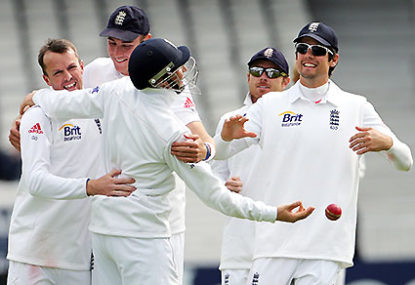England has won the Ashes. A statement that, although not explaining the circumstances, is all that will be seen by future generations.
Many wise and knowledgeable people predicted a result like that – not that you had to be too smart to pick it – for there was a resounding feeling of inevitable Australian failure to this Ashes before it even began.
Only the anticipation of such a nostalgic event and a nation’s hope that a sense of desperation could make it competitive implored us to watch.
Yet what lay ahead of the Australians was something rarely seen in past Ashes. England tactically manoeuvring the shape of its pitches before a series, particularly an Ashes one, is not uncommon.
Their subcontinental qualities, however, must have left the Aussies believing they had caught the wrong plane to Chennai, a confusion I’m sure was only resolved by the sight of the Queen before the second Test at Lord’s.
In that regard, the choice of pitch for the curator was as much hope as it was strategic. For a side with such a statistical advantage over the other, as Roar Expert David Lord has illustrated, it was an odd decision for England to play away from their strengths in the hope that the opposition adapts worse.
It’s no secret that both sides’ bowling strengths are with their seamers, and their batsmen much prefer a hard deck with the ball coming onto the bat. And it’s also understandable that England felt they had a better spinner and that their batsmen were better players of such spin.
Nevertheless, hindsight is bliss, and England’s plan was as sketchy as their infamous ‘Bodyline’ plan of generations past was bold.
England’s plan was hazy for the fact that they gambled on who was in form. As they did in India in late 2012, when Alastair Cook, Kevin Pietersen, and Matt Prior’s batting out-India’d India, they were expected to do such again.
Except Cook and Prior are averaging less than 30 this series with high scores of 62 and 31 respectively, with Pietersen only marginally ahead on an average of 35.
Their failures have further complicated an already erratic ploy. If not for the picturesque Ian Bell, averaging more than anybody in the past three Ashes series on England soil with 70 (midway through the Fifth Test), the result of this last Test could bear far more significance, and England’s plan be left looking as comical as Michael Vaughan.
Still, this is an Ashes series, and when runs are scored is valued differently to how many. An odd statement, yes, but supported by the perplexing fact that Australia boast four of the five leading run-scorers in this series, yet trail.
Furthermore, six of the leading seven run-scorers in the 2009 series also wore the baggy green, and Australia also lost.
It’s what made England’s decision such a sketchy plan – or brilliant, depending on which way you look at it.
Statistics suggest that Australia’s have generally fared better than their English counterparts, but those figures are inflated by the Third and Fifth Tests.
It’s no coincidence that this has occurred when Australia won the toss and batted first on pitches that were only going to get softer. They have encouragingly made best use of such, scoring over 400 and declaring both times.
Only rain in the Third Test denied Australia an outcome. England have never looked like losing the other three Tests, despite the eccentric/heroic cameos that Australian batsmen often present to a dejected audience watching back home.
In some aspects, this reflects the influence of the toss, and the importance of it around England’s plan. It has been near impossible for a side to win batting second, Trent Bridge the closest either side has come.
Scarily for England though, and Australia in a sense, their dependence on the toss has almost become habit, one that they would most likely not want to become too familiar with in the future.
Ironically, England intensified this habit and the effect it has on their success just this week, picking a side for the final Test that was almost dependent on winning the toss.
It makes you wonder – if Michael Clarke had picked right in the first two Test matches, who knows where we would be in this series?
You could say that about every Test series, but you feel as though this Ashes has been determined by such small victories early in each Test.
Ian Bell has saved England and their plan. The runs he has scored, but more importantly when he has scored them, have made England and Australia trade places this series.
While Australia have become more consistent, with a more sources of runs than in the past five years, England has become reliant on one player – much like Australia was with Clarke just recently.
You still can’t look past the fact that Australia has self-destructed in the big moments, and England has managed to keep their heads above water, just as they planned.
Their brilliant scheme, however sketchy it may seem, worked. In the future all we will see is an England victory.
Because after all is said and done this is still an Ashes series, even if it has defied logic and history.





































































































